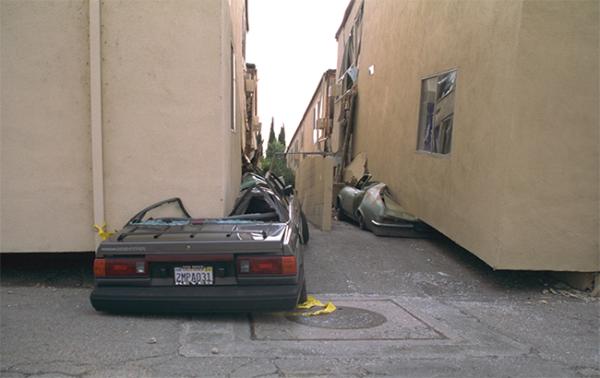It all started with an earthquake
On January 17, 1994, a magnitude 6.7 earthquake known as the Northridge earthquake rocked California's San Fernando Valley—twenty miles northwest of downtown Los Angeles—on a fault no one even knew existed.
According to the Seismic Safety Commission, the earthquake caused an estimated $20 billion in residential damages alone—and only half of that was covered by insurance.
After the dust settled, the Northridge earthquake shook the foundation of the residential insurance industry, which had greatly underestimated the potentially huge costs associated with damage from even a moderate earthquake.
Insurance companies pull back
Since the 1980s, California law has mandated that insurance companies selling homeowners insurance also offer earthquake insurance. Fearing they wouldn't have enough money to pay damage claims to homeowners if another Northridge-like quake hit, many insurance companies greatly limited the number of homeowners policies they wrote.
By January of 1995, companies representing 93 percent of the California homeowners insurance market had either restricted or stopped writing homeowners policies altogether, sending the California housing market into a tailspin.
CEA is born
In 1995, the California Legislature came up with a workable solution it thought would help revitalize the insurance and housing markets.
It created a basic policy that any insurer could sell to comply with the mandatory offer law. The policy provided homeowners basic coverage for the roof over their heads, eliminating costly extras like swimming pools and patios.
In 1996, the California Legislature went one step further and created the California Earthquake Authority (CEA)—a not-for-profit, publicly managed, privately funded entity. Residential property insurers could offer their own earthquake insurance or become a CEA participating insurance company. Over the years, the CEA policy has added more options, including a retrofit discount for eligible homeowners.
Today, CEA provides two-thirds of the residential earthquake insurance policies sold in California. By selling our policies exclusively through these participating insurance companies, CEA has become one of the largest providers of residential earthquake insurance in the world.
A focus on earthquake education, safety, and preparedness
CEA places a high priority on educating California homeowners and renters about how to stay safe during an earthquake, and how to reduce the risk of earthquake damage and loss.
We work with a number of organizations such as the California Office of Emergency Services (CalOES) and the Earthquake Country Alliance (which created The Great California ShakeOut™). We have also joined forces with the American Red Cross, and have worked with United Policyholders.
Our collaborative efforts have helped make Californians more aware of their earthquake risk and become better prepared for the next big one.
CEA Continues To Be Earthquake Strong
In 2011, the CEA and the California Governor’s Office of Emergency Services (Cal OES) formed the California Residential Mitigation Program (CRMP) in order to create more resilient communities that are able to recover from the next damaging earthquake.
In 2013, the CRMP launched Earthquake Brace + Bolt: Funds To Strengthen Your Foundation (EBB). This innovative brace + bolt residential mitigation program helps homeowners lessen the potential for earthquake damage to their house by offering incentive grants of up to $3,000 for a residential seismic retrofit. An EBB seismic retrofit involves bolting a house to its foundation and, when necessary, bracing the cripple walls with plywood, to help prevent the home from collapsing or sliding off its foundation.
In 2021, EBB expanded and—as part of its commitment to diversity and inclusion—for the first time offered income-eligible homeowners a chance to qualify for newly available supplemental grants. These grants may pay for up to 100% of the retrofit cost for eligible homeowners with a verified annual household income at or below the amount stated in the EBB Program Rules.
In February 2023, the second seismic retrofit grant program, Earthquake Soft-Story, was launched in select Bay Area and Southern California cities. Grants of up to $13,000 are offered to retrofit soft-story homes. Soft-story homes have one or more floors of living space built above a garage. These structures are vulnerable to damage because they may not be able to withstand the lateral movement from earthquake shaking. Houses with this condition may be prone to partial or full collapse during an earthquake.
Thousands of homeowners have been able to strengthen their homes through EBB and ESS. CRMP is also currently developing a new grant program for multifamily homes to help support earthquake retrofitting of housing structures with "tuck-under" parking or commercial space on the ground floor. That program is expected to be piloted in 2025.
CEA Continues To Be Earthquake Ready
Today, CEA continues to be financially strong, with an A.M. Best rating of B++ (Good) and about in claim-paying capacity.
Like many property and casualty insurance enterprises around the world we continue to navigate and adapt to challenges resulting from market conditions, and global economic realities.
California Wildfire Fund Administrator
Since 2019, CEA also has administered the Wildfire Fund, a catastrophe fund that provides a source of funding for payment of claims arising from a wildfire caused by any large electrical utility company that meets the legal requirements for participation in the fund.

